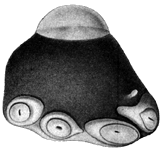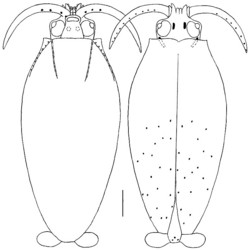Liocranchia valdiviae
Richard E. Young and Katharina M. Mangold (1922-2003)Introduction
L. valdiviae is the deeper-water member of the genus. Younger stages are commonly taken but adults are rarely captured.
Characteristics
- Head
- Beaks: Descriptions can be found here: Lower beak; upper beak.
- Beaks: Descriptions can be found here: Lower beak; upper beak.
- Mantle
- Tubercles absent along middorsal line (i.e., over gladius).
- Tubercles absent along middorsal line (i.e., over gladius).
- Photophores
- 4 oval photophores on eyeball.
Life History
The paralarvae are similar to those of L. reinhardti. Prior to the development of the dorsal row of tubercles in the latter species, L. valdiviae can be recognized by its distinctive chromatophore pattern which includes three small chromatophores on the dorsal, posterior tip of the mantle and a larger patch of chromatophores on the posterior half of the dorsal mantle.
Distribution
Vertical Distribution
In Hawaiian waters L. valdiviae is not a diel vertical migrator although occasionally "wanderers" are found in shallow depths at night. The squid undergoes an ontogenetic descent and generally remains at its daytime depth at night.
Captures were made with both open and opening/closing trawls. Bars- fishing depth-range of opening/closing trawl. Circle- Modal fishing depth for either trawl. Blue-filled circles- Night captures. Yellow-filled circles- Day capture.

Figure. Chart of the vertical distribution of L. valdiviae, Hawaiian waters. Chart modified from Young, 1978.
Geographical Distribution
L. valdiviae is a tropical species found throughout the Indo-Pacific (Nesis, 1982).
References
Nesis, K. N. 1982/87. Abridged key to the cephalopod mollusks of the world's ocean. 385+ii pp. Light and Food Industry Publishing House, Moscow. (In Russian.). Translated into English by B. S. Levitov, ed. by L. A. Burgess (1987), Cephalopods of the world. T. F. H. Publications, Neptune City, NJ, 351pp.
Young, R. E. 1978. Vertical distribution and photosensitive vesicles of pelagic cephalopods from Hawaiian waters. Fish. Bull. 76: 583-615.
About This Page

University of Hawaii, Honolulu, HI, USA
Katharina M. Mangold (1922-2003)

Laboratoire Arago, Banyuls-Sur-Mer, France
Page copyright © 1996
 Page: Tree of Life
Liocranchia valdiviae .
Authored by
Richard E. Young and Katharina M. Mangold (1922-2003).
The TEXT of this page is licensed under the
Creative Commons Attribution-NonCommercial License - Version 3.0. Note that images and other media
featured on this page are each governed by their own license, and they may or may not be available
for reuse. Click on an image or a media link to access the media data window, which provides the
relevant licensing information. For the general terms and conditions of ToL material reuse and
redistribution, please see the Tree of Life Copyright
Policies.
Page: Tree of Life
Liocranchia valdiviae .
Authored by
Richard E. Young and Katharina M. Mangold (1922-2003).
The TEXT of this page is licensed under the
Creative Commons Attribution-NonCommercial License - Version 3.0. Note that images and other media
featured on this page are each governed by their own license, and they may or may not be available
for reuse. Click on an image or a media link to access the media data window, which provides the
relevant licensing information. For the general terms and conditions of ToL material reuse and
redistribution, please see the Tree of Life Copyright
Policies.
Citing this page:
Young, Richard E. and Katharina M. Mangold (1922-2003). 1996. Liocranchia valdiviae . Version 01 January 1996 (under construction). http://tolweb.org/Liocranchia_valdiviae/19597/1996.01.01 in The Tree of Life Web Project, http://tolweb.org/










 Go to quick links
Go to quick search
Go to navigation for this section of the ToL site
Go to detailed links for the ToL site
Go to quick links
Go to quick search
Go to navigation for this section of the ToL site
Go to detailed links for the ToL site